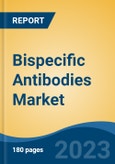Free Webex Call
The Bispecific Antibodies Market was valued at USD 6.80 Billion in 2024, and is expected to reach USD 11.68 Billion by 2030, rising at a CAGR of 9.40%. The global bispecific antibodies market has been witnessing significant growth and innovation in the biopharmaceutical industry. Bispecific antibodies are a class of therapeutic proteins designed to simultaneously target two different antigens, providing a unique approach to treating various diseases, including cancer and autoimmune disorders. Speak directly to the analyst to clarify any post sales queries you may have.
10% Free customizationThis report comes with 10% free customization, enabling you to add data that meets your specific business needs.
Key Market Drivers
Rising Prevalence of Cancer and Autoimmune Diseases
The global bispecific antibodies (BsAbs) market is experiencing rapid expansion, primarily driven by the increasing incidence of cancer and autoimmune diseases worldwide. This trend is significantly boosting the demand for innovative, targeted biologics, positioning bispecific antibodies as a key therapeutic solution. In 2022, global cancer statistics revealed significant healthcare and economic challenges, with approximately 20 million new cancer cases diagnosed and 9.7 million cancer-related deaths recorded worldwide. The prevalence of cancer survivors within five years of diagnosis reached 53.5 million, underscoring the growing burden on healthcare systems to provide long-term care and support.Epidemiological data indicates that 1 in 5 individuals will develop cancer during their lifetime, with gender-specific mortality rates highlighting a higher risk among men (1 in 9) compared to women (1 in 12). These figures emphasize the critical need for innovative therapeutic solutions, early detection strategies, and scalable treatment options to address the rising global cancer burden. This rise is attributed to aging populations, lifestyle changes, and environmental factors. The growing cancer burden is increasing demand for advanced, highly effective therapies, which is propelling the adoption of bispecific antibodies in oncology.
Unlike traditional monoclonal antibodies (mAbs), bispecific antibodies can simultaneously bind to two different antigens, enhancing tumor cell killing while reducing immune evasion. BsAbs can recruit and activate T cells or NK cells to attack tumor cells, offering a powerful alternative to standard chemotherapy and single-target biologics. Many cancer therapies face resistance over time, but BsAbs help overcome resistance mechanisms by targeting multiple pathways. BsAbs provide a more accessible and cost-effective option compared to personalized CAR-T therapies, which require complex manufacturing processes.
Key Market Challenges
Complex Design and Manufacturing
One of the primary challenges in the bispecific antibodies market is the complexity of their design and manufacturing processes. Creating bispecific antibodies that can simultaneously bind to two distinct molecules or cells requires precise engineering. The intricacies of their structure can lead to manufacturing challenges, impacting scalability, production costs, and consistency in quality.Key Market Players
- Amgen Inc
- F. Hoffmann-La Roche Ltd
- Genentech Inc
- Akeso Inc
- Janssen (Johnson & Johnson Private Limited)
- Taisho Pharmaceutical Co Ltd
- Immunocore Ltd
Report Scope:
In this report, the Global Bispecific Antibodies Market has been segmented into the following categories, in addition to the industry trends which have also been detailed below:Bispecific Antibodies Market, By Indication:
- Cancer
- Inflammatory & Autoimmune Disorders
- Others
Bispecific Antibodies Market, By Region:
- North America
- United States
- Canada
- Mexico
- Europe
- Germany
- United Kingdom
- France
- Italy
- Spain
- Asia-Pacific
- China
- Japan
- India
- Australia
- South Korea
- South America
- Brazil
- Argentina
- Colombia
- Middle East & Africa
- South Africa
- Saudi Arabia
- UAE
- Kuwait
Competitive Landscape
Company Profiles: Detailed analysis of the major companies present in the Global Bispecific Antibodies Market.Available Customizations:
With the given market data, the publisher offers customizations according to a company's specific needs. The following customization options are available for the report.Company Information
- Detailed analysis and profiling of additional market players (up to five).
This product will be delivered within 1-3 business days.
Table of Contents
1. Product Overview
2. Research Methodology
3. Executive Summary
5. Global Bispecific Antibodies Market Outlook
6. North America Bispecific Antibodies Market Outlook
7. Europe Bispecific Antibodies Market Outlook
8. Asia-Pacific Bispecific Antibodies Market Outlook
9. South America Bispecific Antibodies Market Outlook
10. Middle East and Africa Bispecific Antibodies Market Outlook
11. Market Dynamics
12. Market Trends & Developments
13. Porter’s Five Forces Analysis
14. Competitive Landscape
Companies Mentioned
- Amgen Inc
- F. Hoffmann-La Roche Ltd
- Genentech Inc
- Akeso Inc
- Janssen (Johnson & Johnson Private Limited)
- Taisho Pharmaceutical Co Ltd
- Immunocore Ltd
Table Information
| Report Attribute | Details |
|---|---|
| No. of Pages | 180 |
| Published | February 2025 |
| Forecast Period | 2024 - 2030 |
| Estimated Market Value ( USD | $ 6.8 Billion |
| Forecasted Market Value ( USD | $ 11.68 Billion |
| Compound Annual Growth Rate | 9.4% |
| Regions Covered | Global |
| No. of Companies Mentioned | 7 |









